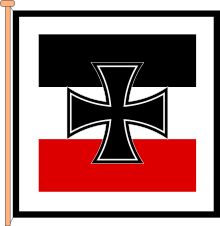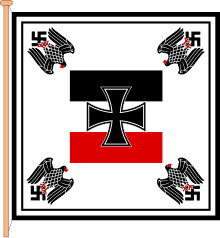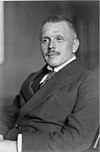| Reichswehrministerium (German) | |
 Entrance to the Bendlerblock. | |
| Ministry overview | |
|---|---|
| Formed | October 1919 (1919-10) |
| Dissolved | 4 February 1938 (1938-02-04) |
| Jurisdiction | Government of Weimar Republic Government of Nazi Germany |
| Headquarters | Bendlerblock, Berlin |
| Minister responsible |
|
The Ministry of the Reichswehr (German: Reichswehrministerium) was the defence ministry of the Weimar Republic and the early Third Reich. Based in the Bendlerblock building in Berlin, it was established in October 1919 under the leadership of a defence minister and staffed mostly from the existing Prussian Ministry of War. Its longest serving Weimar era ministers were the civilian Otto Gessler (almost 8 years) and the former general Wilhelm Groener (4 years).
Under the Nazi government, the Ministry of the Reichswehr was renamed the Reich Ministry of War. It was led by Minister of War General Werner von Blomberg, who had also been the last defence minister. The Ministry was abolished in 1938 and replaced with the Oberkommando der Wehrmacht (Armed Forces High Command) under the direct command of Adolf Hitler.
History
Formation
On 6 March 1919, the Weimar National Assembly – Germany's post-war interim parliament, which was tasked with passing necessary laws while it drafted a constitution for the Republic – enacted the Law on the Formation of a Provisional National Defence Force (Gesetz über die Bildung einer vorläufigen Reichswehr ). It authorized the president of Germany to:
disband the existing Army and to form a provisional Reichswehr, which will protect the Reich's borders, enforce the orders of the Reich government and maintain peace and order within the Reich until the new Armed Forces (Wehrmacht ), which is to be organized by Reich law, is created.
The position of defence minister was established early in 1919 and filled by Gustav Noske on 13 February. On 20 August, President Friedrich Ebert ordered that the Reichswehr Ministry take over from the federal states' war ministries on 1 October, although it was not until 8 November 1919 that the new ministry was officially opened. The heads of Army Command (Heeresleitung ) and the Admiralty – which became Navy Command (Marineleitung ) on 15 July 1920 – were subordinate to the defence minister. The Ministry was for the most part made up of members from the states' war ministries, with the majority coming from the Prussian Ministry of War.
The Prussian armed forces remained under the command of General Walther Reinhardt, the Prussian Minister of War, until the Ministry was disbanded on 30 September 1919. Reinhardt sat on the first two cabinets of the Weimar Republic as a non-voting member until 30 September, as did Admiral Adolf von Trotha in a similar capacity for the Admiralty until 27 March 1920, when the Bauer cabinet resigned.
As a covert replacement for the German Empire's General Staff (OHL), which had been banned by the Treaty of Versailles (Article 160), the Truppenamt was formed within the Reichswehr Ministry in October 1919. General Hans von Seeckt was its first head.
The Reich law to create a new Armed Forces, which had been referred to in the 1919 Law on the Formation of a Provisional National Defence Force, was promulgated as the Defence Act (Wehrgesetz ) on 23 March 1921 by the Weimar Reichstag. It formally established the Reichswehr in compliance with the limits set in the Treaty of Versailles. In § 8 , it stated that: "the Reich President is the supreme commander of the entire Armed Forces. Under him, the Armed Forces minister exercises command over the entire Armed Forces." Paragraph 10 also provided that:
An Army Board (Kammer ) and a Navy Board, whose members are elected by secret ballot, are to be established at the Reichswehr Ministry as advisory and expert bodies. The Army and Navy Boards are directly subordinate to the defence minister.
In § 12, the war ministries of Bavaria, Saxony and Württemberg were dissolved, and command authority was concentrated in the hand of the defence minister.
A Minister's Office (Ministeramt), which served as a top military authority between the minister and the army and navy leadership, was set up on 1 March 1929.
Under the Third Reich
Just over two years after Adolf Hitler and the Nazi Party rose to power, the Proclamation of Military Sovereignty (Verkündung der Wehrhoheit ) of 16 March 1935 created a new Oberkommando der Luftwaffe (OKL) under the Air Ministry and turned the Heeresleitung into the Oberkommando des Heeres (OKH) and the Marineleitung into the Oberkommando der Marine (OKM). The Minister's Office was renamed the Wehrmacht Office. The Defence Act (Wehrgesetz ) of 21 May 1935 made the Führer and chancellor (Hitler) supreme commander of the Wehrmacht. Under him, the renamed minister of war (Reichskriegsminister ) became commander-in-chief of the Wehrmacht (§ 3).
As a result of the Blomberg–Fritsch affair, Hitler took over as commander-in-chief of the Wehrmacht by decree on 4 February 1938. Under the same decree, the functions of the Ministry of War were taken over by the High Command of the Wehrmacht (Oberkommando der Wehrmacht, OKW). The Ministry of War ceased to exist at that point.
Lists of officials
Defence Ministers
See also: List of German defence ministers

- Minister of Defence
| No. | Portrait | Minister | Took office | Left office | Time in office | Party | Cabinet |
|---|---|---|---|---|---|---|---|
| 1 |
 | Noske, GustavGustav Noske (1868–1946) | 13 February 1919 | 22 March 1920 | 1 year, 38 days | SPD | Scheidemann Bauer |
| 2 |
 | Gessler, OttoOtto Gessler (1875–1955) | 27 March 1920 | 19 January 1928 | 7 years, 298 days | DDP | Müller I Fehrenbach Wirth I − II Cuno Stresemann I − II Marx I − II Luther I − II Marx III − IV |
| 3 |
 | Groener, WilhelmWilhelm Groener (1867–1939) | 19 January 1928 | 30 May 1932 | 4 years, 132 days | Independent | Marx IV Müller II Brüning I − II |
| 4 |
 | Schleicher, KurtKurt von Schleicher (1882–1934) | 1 June 1932 | 28 January 1933 | 243 days | Independent | von Papen von Schleicher |
| 5 |
 | Blomberg, WernerWerner von Blomberg (1878–1946) | 29 January 1933 | 21 May 1935 | 2 years, 113 days | Independent | Hitler |
- Minister of War

| No. | Portrait | Minister | Took office | Left office | Time in office | Party | Cabinet |
|---|---|---|---|---|---|---|---|
| 1 |
 | Blomberg, WernerWerner von Blomberg (1878–1946) | 21 May 1935 | 27 January 1938 | 2 years, 251 days | Independent | Hitler |
Ministerial office heads
- Heads of the Ministeramt (Chefs des Ministeramtes)
| No. | Portrait | Chefs des Ministeramtes | Took office | Left office | Time in office |
|---|---|---|---|---|---|
| 1 |
 | Schleicher, KurtGeneral der Infanterie Kurt von Schleicher (1882–1934) | 1 February 1929 | 1 June 1932 | 3 years, 121 days |
| 2 |
 | Bredow, FerdinandGeneralmajor Ferdinand von Bredow (1884–1934) | 1 June 1932 | 30 January 1933 | 243 days |
| 3 |
 | Reichenau, WalterOberst Walter von Reichenau (1884–1942) | 1 February 1933 | 1 February 1934 | 1 year, 0 days |
- Heads of the Wehrmachtamt (Chefs des Wehrmachtamtes)
| No. | Portrait | Chefs des Wehrmachtamtes | Took office | Left office | Time in office |
|---|---|---|---|---|---|
| 1 |
 | Reichenau, WalterGeneralmajor Walter von Reichenau (1884–1942) | 1 February 1934 | 30 September 1935 | 1 year, 243 days |
| 2 |
 | Keitel, WilhelmGeneralmajor Wilhelm Keitel (1882–1946) | 1 October 1935 | 4 February 1938 | 2 years, 127 days |
Army heads
- Heads of the Army Command (Chefs der Heeresleitung)



| No. | Portrait | Chefs der Heeresleitung | Took office | Left office | Time in office |
|---|---|---|---|---|---|
| 1 |
 | Reinhardt, WaltherGeneralmajor Walther Reinhardt (1872–1930) | 13 September 1919 | 22 March 1920 | 191 days |
| 2 |
 | Seeckt, HansGeneraloberst Hans von Seeckt (1866–1936) | 26 March 1920 | 9 October 1926 | 6 years, 197 days |
| 3 |
 | Heye, WilhelmGeneraloberst Wilhelm Heye (1869–1947) | 9 October 1926 | 31 October 1930 | 4 years, 22 days |
| 4 |
 | Hammerstein-Equord, KurtGeneral der Infanterie Kurt von Hammerstein-Equord (1878–1943) | 1 November 1930 | 31 January 1934 | 3 years, 91 days |
| 5 |
 | Fritsch, WernerGeneral der Artillerie Werner von Fritsch (1880–1939) | 1 February 1934 | 1 June 1935 | 1 year, 120 days |
- Commander-in-chief of the Army (Oberbefehlshaber des Heeres)

| No. | Portrait | Oberbefehlshaber des Heeres | Took office | Left office | Time in office |
|---|---|---|---|---|---|
| 1 |
 | Fritsch, WernerGeneraloberst Werner von Fritsch (1880–1939) | 1 June 1935 | 4 February 1938 | 2 years, 248 days |
Navy heads
- Chief of the Admiralty (Chef der Admiralität)
| No. | Portrait | Chefs der Admiralität | Took office | Left office | Time in office |
|---|---|---|---|---|---|
| 1 |
 | Trotha, AdolfVizeadmiral Adolf von Trotha (1868–1940) | 26 March 1919 | 22 March 1920 | 362 days |
| – |
 | Michaelis, WilliamKonteradmiral William Michaelis (1871–1948) Acting | 22 March 1920 | 1 September 1920 | 163 days |
| 2 |
 | Behncke, PaulVizeadmiral Paul Behncke (1869–1937) | 1 September 1920 | 14 September 1920 | 13 days |
- Heads of the Naval Command (Chefs der Marineleitung)
| No. | Portrait | Chefs der Marineleitung | Took office | Left office | Time in office |
|---|---|---|---|---|---|
| 1 |
 | Behncke, PaulVizeadmiral Paul Behncke (1869–1937) | 14 September 1920 | 1 October 1924 | 4 years, 17 days |
| 2 |
 | Zenker, HansVizeadmiral Hans Zenker (1870–1932) | 1 October 1924 | 30 September 1928 | 3 years, 365 days |
| 3 |
 | Raeder, ErichVizeadmiral Erich Raeder (1876–1960) | 1 October 1928 | 1 June 1935 | 6 years, 243 days |
- Commander-in-chief of the Navy (Oberbefehlshaber der Kriegsmarine)
| No. | Portrait | Oberbefehlshaber der Marine | Took office | Left office | Time in office |
|---|---|---|---|---|---|
| 1 |
 | Raeder, ErichGroßadmiral Erich Raeder (1876–1960) | 1 June 1935 | 30 January 1943 | 7 years, 243 days |
References
- "Gesetz über die Bildung einer vorläufigen Reichswehr. Vom 6. März 1919" [Law on the formation of a provisional national defence force. From 6. March 1919 (full text in German)]. documentArchiv.de. Retrieved 2 July 2024.
- ^ "Militärwesen im Deutschen Reich 1919–1932" [Military System in the German Reich 1919–1932]. 100 Jahre Weimarer Republik (in German). Retrieved 2 July 2024.
- ^ "Das Kabinett Scheidemann (13. Februar – 20. Juni 1919)". Das Bundesarchiv (in German). Retrieved 2 July 2024.
- "Reichswehrministerium - Ministry of the Reichswehr". EHRI. Retrieved 2 July 2024.
- "Reichswehrministerium" [Reichswehr Ministry]. Lexikon der Wehrmacht (in German). Retrieved 2 July 2024.
- Pöhlmann, Markus (10 March 2016). Daniel, Ute; Gatrell, Peter; Janz, Oliver; Jones, Heather; Keene, Jennifer; Kramer, Alan; Nasson, Bill (eds.). "Prussian War Ministry". 1914–1918-online. International Encyclopedia of the First World War. Freie Universität Berlin. Retrieved 2 July 2024.
- "Truppenamt (TA) im Reichswehrministerium" [Truppenamt (TA) in the Reichswehr Ministry]. Lexikon der Wehrmacht (in German). Retrieved 5 July 2024.
- ^ "Wehrgesetz. Vom 23. März 1921" [Defense Act. From 23 March 1921 (full text in German)]. documentArchiv.de. Retrieved 2 July 2024.
- "The Nazi Party: Military Organization of the Third Reich". Jewish Virtual Library. Retrieved 5 July 2024.
- "Wehrgesetz. Vom 21. Mai 1935" [Defence Law. From 21 May 1935]. Wikisource (German) (in German). Retrieved 5 July 2024.
- Scriba, Arnulf (14 September 2014). "Die Fritsch-Blomberg-Affäre". Deutsches Historisches Museum (in German). Retrieved 5 July 2024.
- "Digitalisierte Bestände der Abteilung Militärarchiv: Bestand Reichswehrministerium / Reichskriegsministerium" [Digitised Holdings of the Military Archives Department: Reichswehr Ministry / Reich War Ministry Holdings]. Das Bundesarchiv (in German). 11 October 2019. Retrieved 5 July 2024.
External links
- (in German) Article on adlexikon.de Archived 2007-09-27 at the Wayback Machine